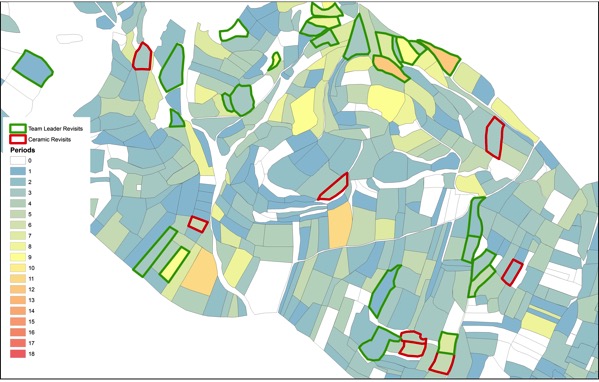There’s a good bit of buzz lately about Apple Music’s “curated” playlists, and TIDAL, my preference for a music streaming service, offers a range of curated music playlists as well. In general, the term curation, like crafted, artisanal, or any of the other tech-media, marketing buzzwords has come to mean that a human, rather than an algorithm has produced a collection. As many, many have observed, the term curation is annoying and overused.
But I still want to use for a little bit in reference to our work on the Western Argolid Regional Project. This morning, I took some time out of the field to start to analyze some of our finds and field data. We plan to revisit a few units before the season concludes and to collect some more material. Our hope is that these targeted revisits will help us both to refine our survey methods by offering some points to calibrate our sampling strategy, they’ll help us produce more robust assemblages of types of pottery that might only appear in very small quantities using our typical collection approach, and revisits will allow us to document archaeological features a bit more intensively than we would have time and resources to do over the course of intensive survey.

We target sites for revisit in three ways. First, our field teams can tick a check box and provide a brief explanation for why a particular unit is worth revisiting. Our ceramicists, Scott Gallimore and Sarah James, can also identify units as being interesting, important, or confusing and consequently worth revisiting. Finally, we can analyze data through our GIS and databases that target units with certain characteristics (such as low visibility with either high densities or diverse assemblages). Our revisit lists generated by team leader and ceramicists are not fortified by statistics, but generated through careful observations and total situational awareness. These units represent the slow archaeology approach to landscape and artifact analysis.
So far, it has been heartening to recognize that the lists of revisit units curated by our team leaders and ceramicists are remarkably consistent with the units generated from my analysis of our various databases. In fact, combining the curated list of unit with list of units generated through our analysis of GIS tend to complement each other by expanding the potential target units for revisit. As we nuance the criteria for revisit a bit over the next week, I’m sure that we’ll discover some counterintuitive units that will serve as tests of our archaeological instincts. For now, though, we’ll proceed into the final week of the season with just a bit of confidence that our experiences in the field and at the pottery tables reflects the complexity of our study area.